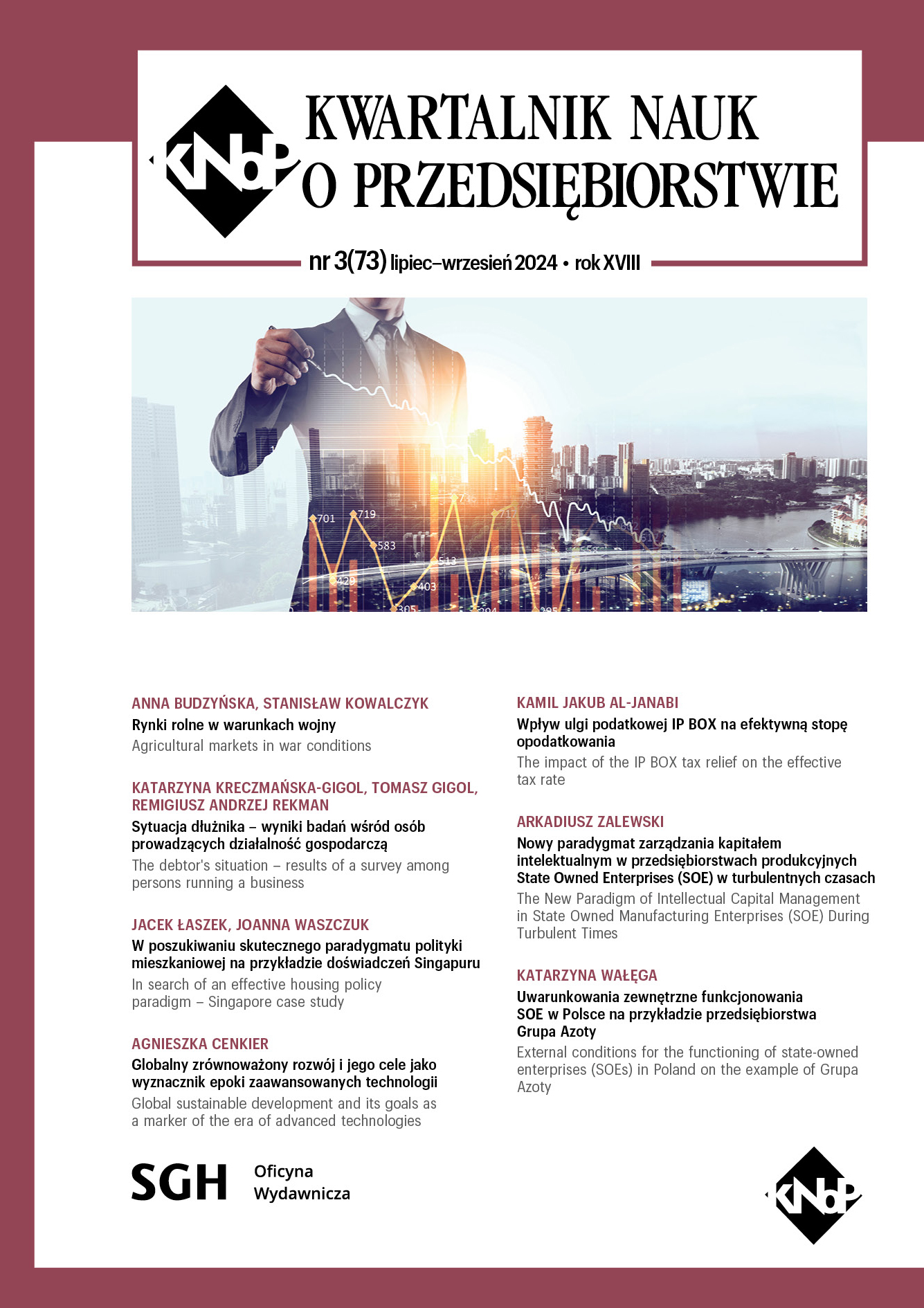The impact of the IP BOX tax relief on the effective tax rate
Main Article Content
Abstract
Tax relief is the possibility of reducing the tax payable. One of the tax reliefs in polish legal and tax system is the IP BOX relief. The IP BOX relief allows taxation of certain income from qualified intellectual property rights at a preferential rate of 5% of income tax. The article presents the impact of the IP BOX tax relief on the effective tax rate in sole proprietorship and indicates a clear decline in interest in the tax relief by sole proprietorships. The literature on the subject, tax laws and the websites of the Ministry of Finance have been analysed. The research methods used in this article are: inductive and deductive method, monographic method, comparative analysis of available literature on the subject, articles available in professional journals, Internet resources as well as statistical and legal and economic methods. Studies have shown that the inclusion of the IP BOX tax relief in the annual income tax return by a sole proprietorship reduces the effective tax rate of a given enterprise.
Downloads
Article Details

This work is licensed under a Creative Commons Attribution 4.0 International License.
The author of the article declares that the submitted article does not infringe the copyrights of third parties. The author agrees to subject the article to the review procedure and to make editorial changes. The author transfers, free of charge, to SGH Publishing House the author's economic rights to the work in the fields of exploitation listed in the Article 50 of the Act of 4 February 1994 on Copyright and Related Rights – provided that the work has been accepted for publication and published.
SGH Publishing House holds economic copyrights to all content of the journal. Placing the text of the article in a repository, on the author's home page or on any other page is allowed as long as it does not involve obtaining economic benefits, and the text will be provided with source information (including the title, year, number and internet address of the journal).
References
Burak K. [2005], Konkurencja podatkowa, Biuro Studiów i Ekspertyz, Wydział Studiów Budżetowych,
„Informacja Kancelarii Sejmu”, nr 1152, s. 4.
Felencikowski T., Nogalski B. [2003], Controlling podatkowy – zagadnienia denotacyjne,
w: Zarzecki D. (red.), Zarządzanie finansami. Mierzenie wyników i wycena przedsiębiorstw,
Wydawnictwo Naukowe Uniwersytetu Szczecińskiego, Szczecin.
Górecki P. [2014], Australijskie media ujawniają, jak Apple unika płacenia podatków, Wyborcza.
biz, 7 marca, https://wyborcza.biz/biznes/7,147582,15585043, australijskie-media-ujawniajajak-
apple-unika-placenia-podatkow.html (data dostępu: 18.01.2024).
Interpretacja [2019a], Interpretacja indywidualna Dyrektora Krajowej Informacji Skarbowej z dnia
stycznia 2019 r., sygn. 0111‑KDIB1-3.4010.538.2018.2. APO.
Interpretacja [2019b], Interpretacja indywidualna Dyrektora Krajowej Informacji Skarbowej z dnia 28 maja 2019 r., sygn. 0113‑KDIPT2-3.4011.167.2019.3. PR.
Jarzębska M. [2016], Dochody nieujawnione jako przedmiot opodatkowania podatkiem dochodowym od osób fizycznych, „Zeszyty Naukowe PWSZ w Płocku Nauki Ekonomiczne”, t. XXIV.
Konstytucja Rzeczypospolitej Polskiej z dnia 2 kwietnia 1997 r. (Dz.U. 1997, nr 78, poz. 483).
Linka R. [2020], Ulga IP Box – obliczanie zaliczek na podatek dochodowy, „Biuletyn Instytutu Studiów Podatkowych, Doradztwo Podatkowe”, nr 3.
Lord S. [2014], The UK Patent Box Tax relief on innovation, Deloitte.
Mahoux B., Gérard M. [2016], On the effectivity of tax incentives: Patent Box Regimes and Allowance for Corporate Equity, Université catholique de Louvain, Louvain-la-Neuve, Belgium.
Mariański A. [2021], Ordynacja podatkowa. Komentarz, CH Beck, Warszawa.
Moczydłowska W. [2022], Wnioski o interpretacje podatkowe i skargi do sądów w 2021 roku, Prawo.pl, 16 marca, https://www.prawo.pl/podatki/wnioski-o-interpretacje-podatkowe-i-skargi-dosadow-w-2021‑roku,514036.html (data dostępu: 30.11.2022).
Modzelewski W. [2020], Wstęp do teorii podatków i prawa podatkowego (Materiał problemowy dla studentów) Część II, „Prawo Finansowe i Skarbowość”, s. 7–8.
Modzelewski W., Słomka M., Bielawny J., Radzikowski K., Safian W., Szymocha M., Wojciechowski M., Zagórski M., Zyśk P. [2022], Komentarz do ustawy o podatku dochodowym od osób fizycznych, Art. 30ca PDOFizU, wyd. 18.
Nykiel W. [2002], Cele i funkcje ulg i zwolnień podatkowych, w: Regulacje prawno-podatkowe i rozwiązania finansowe. Pro publico bono. Księga jubileuszowa Profesora Jana Głuchowskiego, Towarzystwo Naukowe Organizacji i Kierownictwa „Dom Organizatora”, Toruń.
Objaśnienia [2019], Objaśnienia podatkowe z 15 lipca 2019 r. w sprawie IP BOX – dotyczące stosowania przepisów przyznających preferencyjne opodatkowanie 5% stawką podatkową dochodów uzyskiwanych przez podatnika z kwalifikowanych praw własności intelektualnej, Podatki.gov.pl, 16.07.2019.
OECD [2015], OECD/G20, Base Erosion and Profit Shifting Project, Action 5: Agreement on Modified Nexus Approach for IP Regimes, https://www.oecd.org/ctp/beps-action-5‑agreement-onmodified-nexus-approach-for-ip--regimes.pdf (data dostępu: 1.05.2023).
OECD, Podręcznik Frascati [2015], Zalecenia dotyczące pozyskiwania i prezentowania danych z zakresu działalności badawczej i rozwojowej, OECD Publishing, Paris 2015, tłum. Przepiórkowska D., GUS, Warszawa 2018, s. 47, https://doi.org/10.1787/9788388718977‑pl.
OECD [2017], Harmful Tax Practices – 2017 Progress Report on Preferential Regimes: Inclusive Framework on BEPS: Action 5, OECD/G20 Base Erosion and Profit Shifting Project, OECD Publishing, Paris.
OECD [2018], OECD/G20 Base Erosion and Profit Shifting Project.
Patent Box relief statistics: September 2022, HM Revenue & Customs, 2022, https://www.gov.uk/government/statistics/patent-box-reliefs-statistics/patent-box-relief-statistics-september-2022 (data dostępu: 30.11.2022).
Skeie Ø. B., Johansson Å., Menon C., Sorbe S. [2017], Innovation, Patent Location and Tax Planning by Multinationals, Organisation de Coopération et de Développement Économiques, Economics Departments Working Papers no. 1360.
Sobocka-Szczapa H. [2010], Zasady pisania prac licencjackich i magisterskich. Poradnik dla studentów, Społeczna Wyższa Szkoła Przedsiębiorczości i Zarządzania w Łodzi, www.mchmielecki.pbworks.com/f/Zasady_pisania_prac_licencjackich_i_magisterskich._Porad.pdf (data dostępu: 1.05.2023).
Sztuba W. [2016], Efektywne opodatkowanie przedsiębiorstw, Seria: Biblioteka Przeglądu Podatkowego, Wolters Kluwer, Warszawa.
Ustawa z dnia 26 lipca 1991 r. o podatku dochodowym od osób fizycznych (Dz.U. 1991, nr 80, poz. 350 z późn. zm.).
Ustawa z dnia 29 sierpnia 1997 r. – Ordynacja podatkowa (Dz.U. 1997, nr 137, poz. 926 z późn. zm.; Dz.U. 2015, poz. 613 z późn. zm.).
Wójtowicz W. [2005], Preferencje w formie ulg podatkowych jako istotny element struktury podatku, w: W kręgu prawa podatkowego i finansów publicznych. Księga dedykowana Profesorowi Cezaremu Kosikowskiemu w 40‑lecie pracy naukowej, Lublin.
Wyrok NSA z 5.12.2007 r. (II FSK 1238/06, Legalis).
Wyrzykowski W., Kasprzak P. [2016], Ulga podatkowa jako instrument realizacji pozafiskalnych funkcji podatków, „Zarządzanie Finansami i Rachunkowość”, nr 4 (1).

